Ha Giang’s Local Markets: The Cultural Beauty of the Highlands
Ha Giang’s local markets offer more than just the everyday exchange of goods. They are a window into the region’s soul, showcasing the unique traditions of the Hmong, Tay, and Dao ethnic groups. In the following article, MOTOGO Tours will summarize the TOP 6 local markets and note some things you should know when participating.
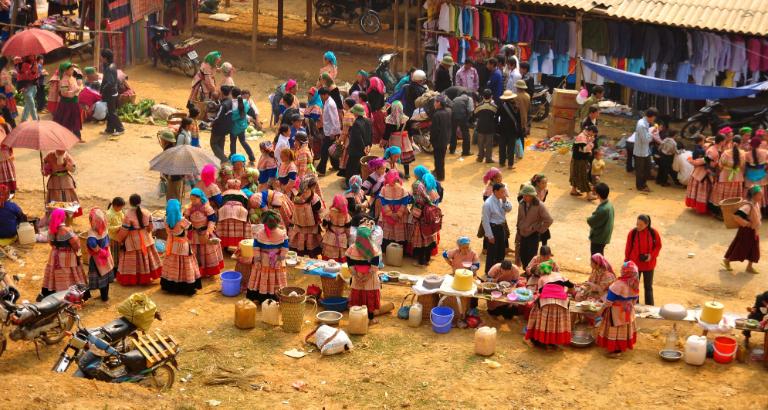
The Role of Local Markets in Ha Giang’s Culture and Economy
The foundation of both the culture and economy of the area is Ha Giang’s local markets. Ethnic groups including the Hmong, Tay, and Dao congregate in these marketplaces not just to trade but also to interact, distribute news, and preserve customs. Markets are essential for community engagement in a distant like Ha Giang, particularly since many villages are cut off by difficult terrain.
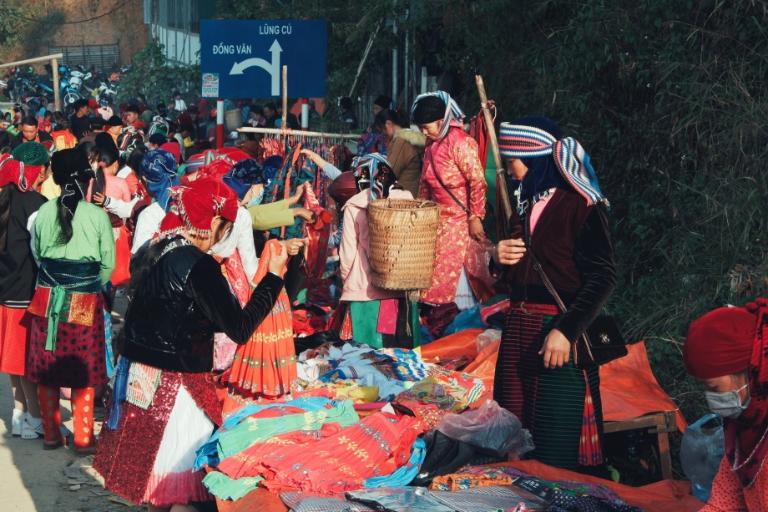
Economically, these marketplaces are vital since they provide local residents with a means to market goods including textiles, handicaps, cattle, and crops—often produced with knowledge handed down over the years. Reflecting the self-sustaining character of rural life, several places still have ancient bartering systems whereby items are swapped instead of sold for money.
With every neighborhood proudly showcasing its own food, apparel, and handicaps, these marketplaces also highlight ethnic variety. Not just goods but also markers of cultural legacy are handwoven fabrics, medicinal herbs, and traditional clothing. Supporting local farmers and artists, visitors have the opportunity to personally encounter this variety.
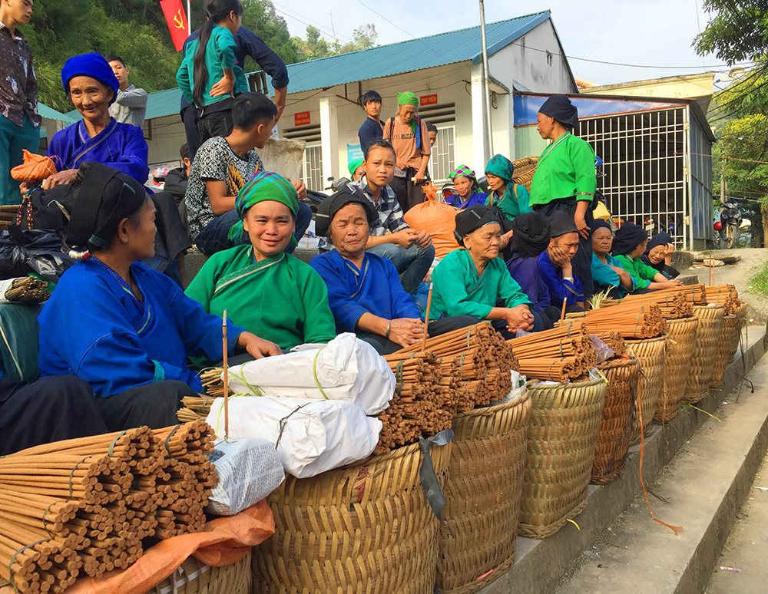
Beyond business, the markets are essential for maintaining cultural traditions since market days are usually joyful occasions when people dress in traditional clothing, barter, and participate in social events. Though efforts are required to guarantee that the sustainability of these practices is kept, they also offer financial advantages, particularly with the increasing interest from visitors.
>>> Ethnic Minorities in Ha Giang: Discovering Their Rich Traditions and Cultures
A Guide to Ha Giang’s Vibrant Local Markets
With a variety of ethnic groups living there, Ha Giang provides guests with the special experience of its traditional marketplaces, each imbued with local character. Here are some of the most prominent markets in the area:
1. Yen Minh Market
Situated 100km from Ha Giang town in the northeastern border region of Yen Minh, this area has some of the most vivid and plentiful marketplaces in the province. Yen Minh is well-known for not only its gorgeous pine trees but also for its busy marketplaces. These are some of the well-liked ones:
- Yen Minh Market: Held every Sunday morning.
- Bach Dich Market: Comprising three smaller markets – Ban Muong, Moc 9 (also known as Moc 358), and the central market of the commune. These rotate on days based on the lunar calendar’s Monkey and Tiger days.
- Duong Thuong Market: Held every Friday morning.
- Du Gia Market: A rustic market held once a week, on Fridays, in the heart of the commune, showcasing the rich cultural heritage of the ethnic people.
- Mau Due Market: Takes place every Sunday morning.
- Phu Lung Market: A lively gathering of locals and traders.
- Sung Trang Market: Also held on Sunday mornings.
- Other Markets: Sung Thai, Lung Ho, Ngoc Long, Mau Long, and Minh Markets add to the charm of Yen Minh
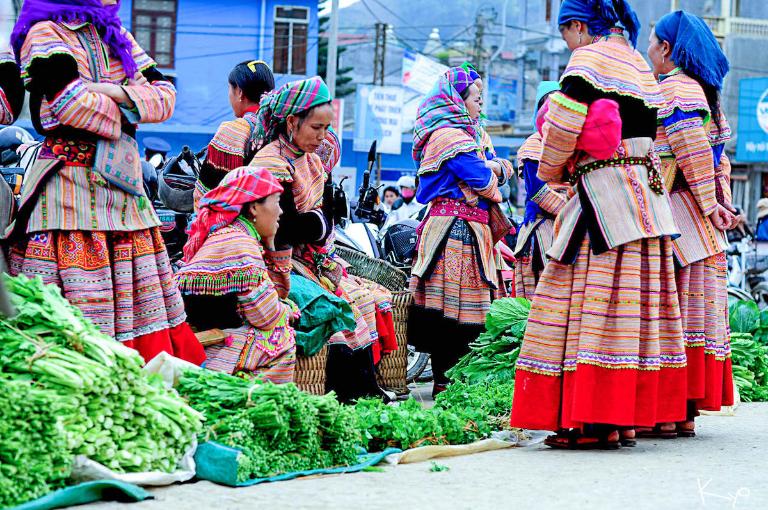
2. Quan Ba Market
Quan Ba, in northernmost Vietnam, boasts various markets that wonderfully capture the cultural core of Ha Giang. Ignoring these markets means ignoring a real experience of local customs and way of life. Among the especially notable markets in Quan Ba are:
- Quan Ba Town Market: Held every Saturday morning in the heart of Tam Son town.
- Cao Ta Tung Market: This market serves three communes: Cao Ma Pờ, Ta Van, and Tung Vai, and is held every Friday.
- Lung Tam Market: A vibrant local hub for trading.
- Bat Dai Son Market: Positioned near the border, this market facilitates cross-border trade with China.
- Quyet Tien Market: Takes place every Saturday morning.
- Trang Kim Market: Located in Dong Ha commune, it operates on lunar days of Goat and Ox.
- Nghia Thuan Market: This market alternates between Vietnam and China, operating on Dragon and Dog days in the lunar calendar.
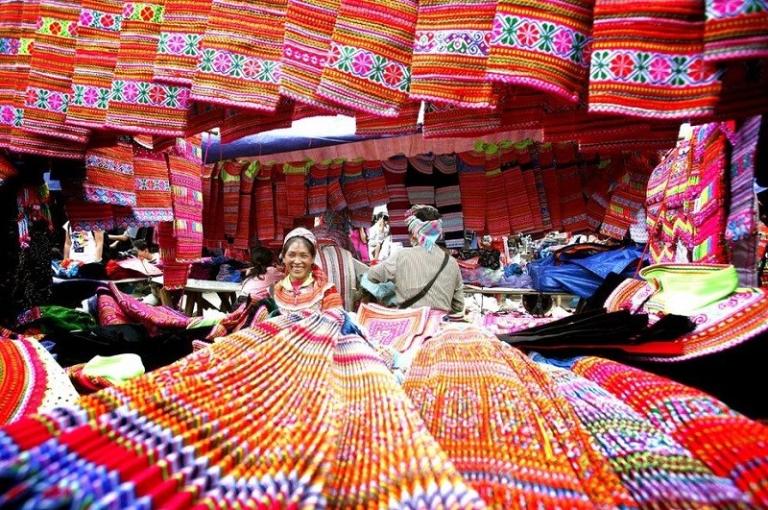
3. Dong Van Market
Dong Van district’s markets combine several ethnic groups—including the Hmong, Dao, and Tay—who trade handwoven fabrics, agricultural items, and animals, under one roof. These markets provide a great degree of cultural immersion. Key markets in Dong Van consist in:
- Dong Van Central Market: Also known as Dong Van Market, this bustling market is held every Sunday morning in the town center.
- Sung Trai Market: Held on lunar Ox and Goat days.
- Lung Phin Market: Operates on lunar Tiger and Monkey days.
- Pho Cao Market: This market gathers on Dragon and Dog days in the lunar calendar.
- Xa Phin Market: Held on lunar Snake and Pig days.
- Sung La Market: A weekly rotating market that shifts one day earlier each week.
- Ma Le Market: Held on lunar Rat and Horse days.
- Lung Cu Market: A border town market held on Goat and Ox days.
- Pho Bang Market: Operates on lunar Horse and Rat days.
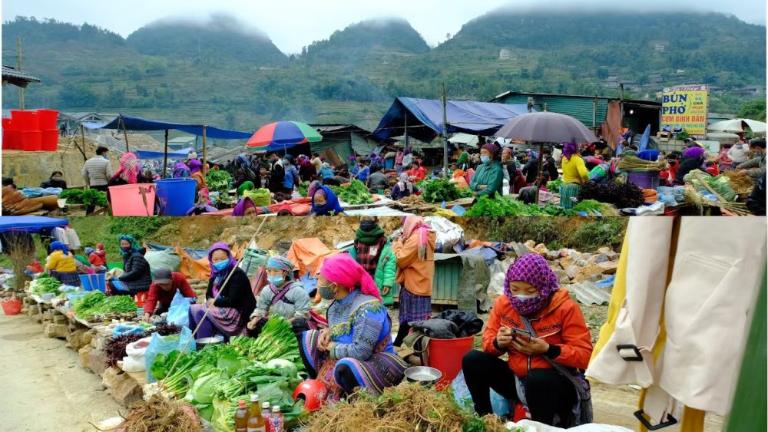
4. Meo Vac Market
Said to be a “grand meeting” for the northern Ha Giang ethnic groups, Meo Vac’s marketplaces are the biggest and most varied in the province. From agricultural goods to livestock and handcrafted fabrics, these markets present a diverse cultural tapestry. Meo Vac district has must-visit markets including:
- Son Vi Market: Held every Sunday morning.
- Meo Vac Central Market: The largest market, held every Sunday morning.
- Niem Son Market: Held every five days.
- Khau Vai Love Market: A unique and famous market that is held only once a year on the 27th of the third lunar month. Khau Vai Market is also open regularly on the 2nd, 7th, 12th, 17th, 22nd, and 27th of each lunar month.
- Sung Tra Market: Held every Saturday.
- Other Markets: Lung Pu, Tat Ngan, Nam Ban, Xin Cai, and Thuong Phung Markets.
Meo Vac is particularly well-known for its unique indigenous food, which includes maize cakes, Au Tau porridge, Thang Co, Men Men,… While shopping the marketplaces, don’t miss these mouthwatering cuisine!
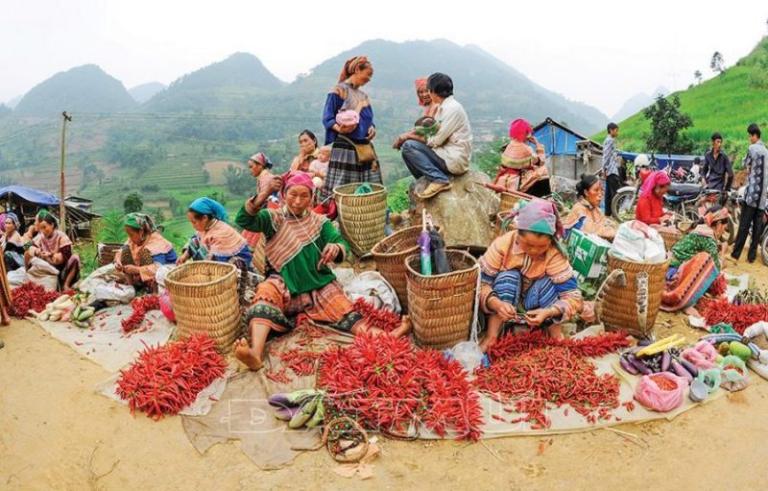
5. Xin Man Market
Nestled in western Ha Giang, Xin Man is renowned for its tranquil surroundings. Its markets give a window into the daily existence of the ethnic groups living here. Among several prominent markets are:
- Coc Pai Market: The district’s main market, held every Sunday morning.
- Pa Vay Su and Nan Xin Markets: Held every Thursday.
- Chi Ca and Xin Man Markets: Open every Friday.
- Ban Diu Market: Another bustling spot for local trade.
- Then Phang Market: Known as the Km26 Market, it opens on Saturday mornings.
Each of the other smaller markets in Xin Man—Coc Re, Ta Nhiu, Nan Ma, Ban Ngo, Quang Nguyen, Thu Ta, Che La, Nam Dan, Na Chi, and Khuon Lung Markets—offers a different local experience.
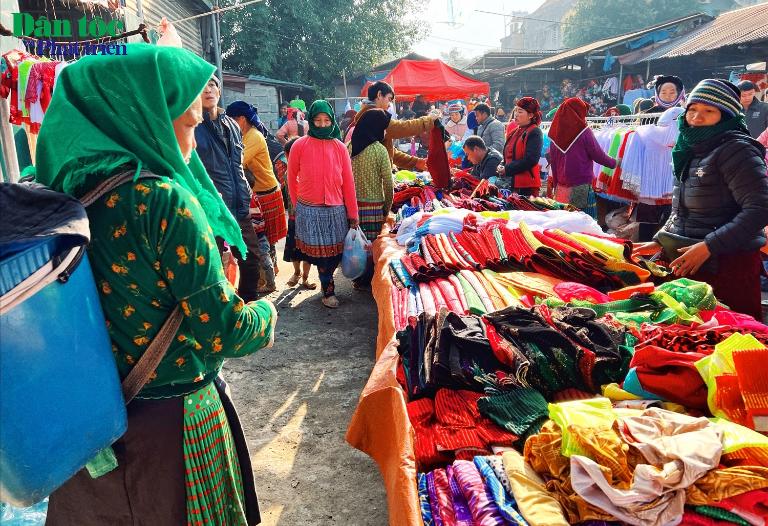
6. Hoang Su Phi Market
Apart from its renowned golden rice terraces, Hoang Su Phi boasts ethnologically rich markets reflecting the customs of the nearby ethnic groups. Some of the main markets consist in:
- Vinh Quang Market: Also known as Hoang Su Phi Market, held every Sunday morning.
- Thang Tin Market: Operates on Saturday mornings.
- Ban Luoc and Ban May Markets: Smaller, yet equally vibrant.
- Other Markets: Hoang Su Phi also hosts various smaller markets like Ban Nhung, Ban Peo, Ban Phung, Chien Pho, Dan Van, Ho Thau, Nam Son, Nang Don, Nam Dich, Nam Khoa, Nam Ty, Ngam Dang Vai, Po Lo, Po Ly Ngai, San Sa Ho, Ta Su Choong, Tan Tien, Then Chu Phin, Thong Nguyen, Tu Nhan, and Tung San Markets.

How to Experience Ha Giang’s Local Markets Like a Local
Seeing Ha Giang’s markets as a local goes beyond just shopping; it’s about really engaging yourself in the rich culture, interacting with the people, and learning about the customs influencing these energetic centers. This thorough guide will help you maximize your trip to Ha Giang’s neighborhood markets and interact with the local population.
1. Visit with a Local Guide
Hiring a local guide will turn your market experience—from a basic shopping trip—into a cultural vacation. In addition to guiding you through the booths, an experienced guide will provide information on the goods, sellers, and market importance within the local community. They can introduce you to nearby artists, set the background for the handcrafted items, and clarify the conventions surrounding buying and negotiating.
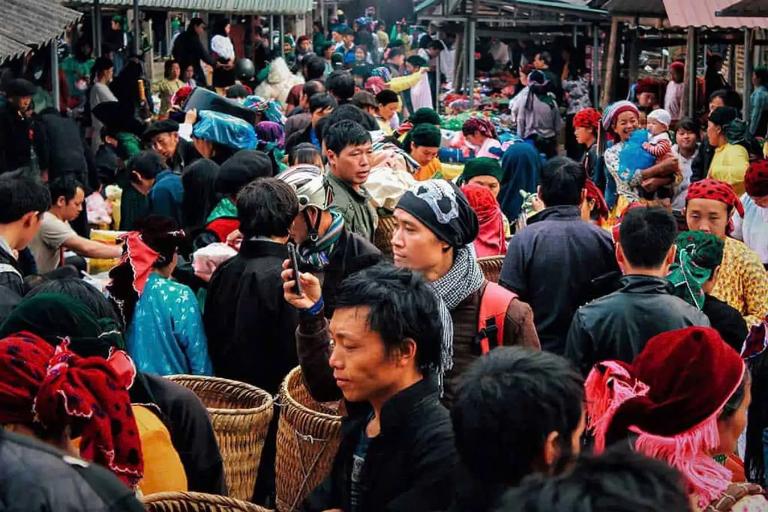
2. Plan Your Visit on Market Days
Every market in Ha Giang runs on designated days—often weekly. For example, Dong Van Market is active on Sundays, whereas Meo Vac Market also opens on that day. Researching the market days ahead lets you enjoy the vibrant scene when nearby businesses and artists get together for trade.
3. Engage with the Local Community
Direct local interaction is one of the finest ways to enjoy Ha Giang’s marketplaces. Don’t shy; approach suppliers and probe their offerings. Locals are generally happy to offer their knowledge whether your interests are in learning the history behind a classic meal or how a given textile is produced.

4. Try Local Foods
Any market experience has food as a basic component; Ha Giang is no exception. Use the chance to taste regional cuisine right at the market. Fresh, mouthwatering cuisine including grilled meats, sticky rice, and local specialties like “thang co,” a traditional meal created from horse meat, is sometimes found at street food booths. Along with satisfying your appetite, trying these dishes lets you taste the culinary legacy of the area.
5. Observe Market Etiquette
Knowing and honoring local customs will improve your trip. Although haggling is somewhat frequent in Ha Giang’s markets, one should handle this habit with respect and fun. Offer a price less than what you would be ready to pay first, and then expect a lighthearted back-and-forth. This conversation has the purpose of strengthening the relationship between buyer and seller rather than only about the price.
Seeing the Ha Giang local markets is like entering a living museum. Every stall, every object, every hand-shake reveals a tale of custom and ethnic pride. Ha Giang’s marketplaces are a must-visit for any visitor trying to really feel the spirit of northern Vietnam, whether their search is for unusual mementos or just appreciation of the surroundings.
Related Posts:
- Hmong Kings’ Palace: A Cultural Treasure in Ha Giang
- Yen Minh Pine Forest: A Hidden Gem in Vietnam’s Highlands
- Exploring Tu San Alley: A Hidden Gem in Ha Giang, Vietnam
- Nho Que River in Ha Giang – A Journey Through Natural Beauty
- Pao’s House: A Place Reflecting the Beauty of Hmong Culture












Be the first to comment!